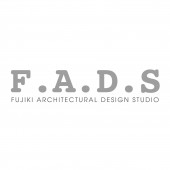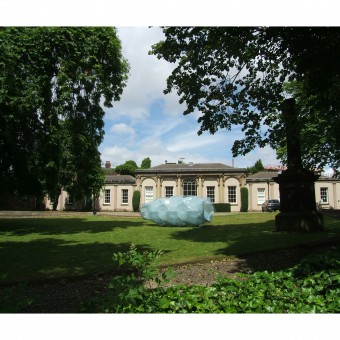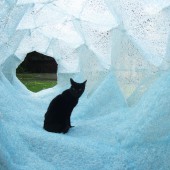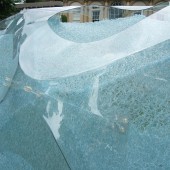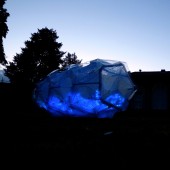DESIGN NAME:
Aqua Scape the Orangery Version
PRIMARY FUNCTION:
Whole Plastic Architecture
INSPIRATION:
We were inspired from a jellyfish and a small shrimp because they are boneless. We were received an e-mail from Beam Gallery in UK and were requested to carry Aqua-scape (the first version) from Japan to UK. But, we thought it was impossible because Aqua-scape was big and heavy. So, we proposed a half size. However, if we made a half size Aqua-scape, a thickness of material would become a half size. Then, the strength of material would be we weaker. For that reason, it was difficult to make it.
UNIQUE PROPERTIES / PROJECT DESCRIPTION:
BONELESS ARCHITECTURE MADE OF ONLY PLASTIC MATERIALS: This is the second version of Aqua-scape. The first one had completed as the first prototype of Whole Plastic Architecture. Aqua-scape was a soft and boneless architecture. This Aqua-scape The Orangery version has a double skin system although the first version was a single skin. If I say the first version was boneless like a jellyfish, I can say the Orangery version is like a small shrimp because it is wrapped by transparent soft shell.
OPERATION / FLOW / INTERACTION:
SPACE FOR CHILDREN: We made it as "Space for Children". So, only children can enter this work. We were able to meet indeed a lot of smiles of children during the exhibition.
PROJECT DURATION AND LOCATION:
Beam Gallery (The Orangery) in Wakefield, England, UK
|
PRODUCTION / REALIZATION TECHNOLOGY:
MATERIAL: The outer skin is made of a transparent 2mm thick polycarbonate sheet and the inner skin is a net structural 10mm thick cushion which was made of tubular polyethylene fiber. A net structural cushion is the one that the straw fiber in the midair that can be done with EVA or polyethylene is chiefly paid to attention as a cushion material for the bed by a transparent material with the welded three-dimensional spring structure in the reticulation. STRUCTURE: It is form resistance structure applied the ORIGAMI technique. CONSTRUCTION METHOD: The inner skin is made entirely by weaving a belt of a net structural cushion measuring 0.5m x 4m.
SPECIFICATIONS / TECHNICAL PROPERTIES:
The size of this work is width:1.5m by hight:1.5m by length:4m.
TAGS:
Plastic, Origami, Jellyfish, Small Shrimp, Space for Children
RESEARCH ABSTRACT:
FORM RESISTANCE STRUCTURE BY ORIGAMI TECHNIQUE: Not only the materials but also the structure and the construction method have been unsolved problems for long time since the project started, because it was very difficult to realize a soft and boneless architecture. When we were almost giving up the achievement of the concept to make it by using only plastic materials, we could find out Net structural cushion at last. A net structural cushion is made from EVA or polyethylene straw fiber as a cushion material for the bed with the reticulated three dimensional spring structure. However, a net structural cushion was unexpectedly heavy. It was occurred problem how to support the self-weight. After the many trials were failed, I concentrated to research the form resistance structure. An appropriate shape is given to the material and the structure that strength is obtained is called form resistance structure. After I folded many papers like ORIGAMI, a bright idea hit me by getting a hint from the thinking of Dr. Kresling. I could make the ruggedness on the surface of the cylinder like the paragraph seen in the bamboo that did abnormal growth. Then, the effect was similar to that of the PCCP shell.
CHALLENGE:
This project started from one image Soft space like water. Is it possible to create a space by weaving a soft plastic material like cloth? Our study had been repeated with a lot of experiments aiming at the achievement of the initial image. However, despite trying many materials, most of our experiments had failed. Finally, we found a way to weave belts of 0.5m by 4m net structural cushions and bend them to create irregularities. However, because a net structural cushion was elastic, it could not maintain its shape just by bending it. Therefore, we decided to connect the vertices each other of the fold lines with a tension material, with the meaning of introducing compressive force to the material in advance.
ADDED DATE:
2022-03-23 16:34:56
TEAM MEMBERS (9) :
ARCHITECT: Ryumei Fujiki, Yukiko Sato, DESIGN FIRM: F.A.D.S + Fujiki Studio, KOU::ARC, TEAM MEMBERS: Masahiro Hoshida, Takehito Kusanagi, Kenta Ochiai, Aki Sakai, Kazuhiro Shimura, Soh Kurihara , Itaru Morimoto, Keiya Sakashita and Shuya Tasaki
IMAGE CREDITS:
Fujiki Studio, KOU::ARC
PATENTS/COPYRIGHTS:
Fujiki Studio, KOU::ARC
|
